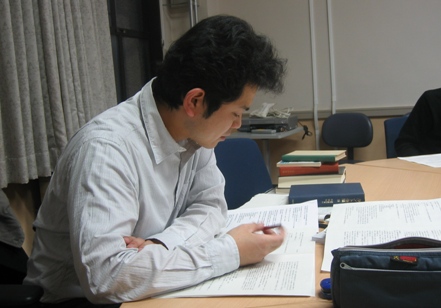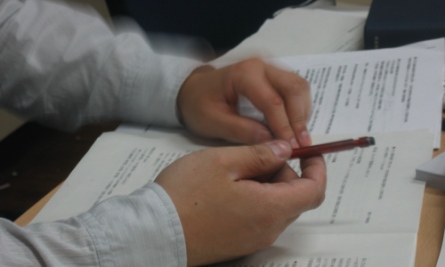Report: "Philosophy and University" #2: Kant's "The Conflict of the Faculties"
The Conflict of Faculties (1798) along with Anthropology from a Pragmatic Point of View is one of the last works Kant published in his lifetime. Several of the essays of the first edition were banned by the censorship and in the preface there is an excuse to Friedrich Wilhelm II, who did the censorship. A theory of the university is developed in the first part “Conflict of the Faculty of Philosophy and the Faculty of Theology”. Although only 20 pages in the Japanese translation it really poses an abundance of questions.

In Kant’s time, the university was composed by three advanced faculties: faculty of theology, faculty of law and faculty of medicine. The doctrine of the superior faculties had a strong influence on the people. The object of the faculty of theology was the eternal happiness of every person, that of law - the civic happiness of every member of society, and that of medicine – the physical happiness (longevity and health). The superior faculties were authorized by the government and by consolidating textual codes (The Bible, The State Law, The Medical Regulations) exerted a direct influence on the public life. The government by permitting and centralizing the doctrines of these faculties, realizes its state authority.
On the other hand, the lower faculty (the faculty of philosophy) was independent from the state interests and its doctrine relied only on the reason of the people. The Faculty of Philosophy was not backed up by state authority, but its freedom to decide about the education is guaranteed. The Faculty of Philosophy was not opposing to the state authority an anti-authority, but a certain non-authority, that is, by opposing the reason, which is of a different nature from authority, it challenges the limits of authority from within (Derrida). The Faculty of Philosophy is defined within the university system and at the same time it covered all the spheres of academic learning by holding the unconditional right to apply critical reason. Consequently the aporia of the Faculty of Philosophy will become a question how to situate the Faculty of Philosophy with its duality of a limited place and a universal non-place within the university system.
The conflict of the higher and lower faculties is legal, it is not war. If the higher faculties as a right wing protect the government regulations, then, the lower faculty (Faculty of Philosophy) closely enquires into matters and advance objections. As far as the Judge of Reason makes the judgment to present the truth to the public, this conflict is effective for the state authority as well. In this case as if by the lever effect, as for the loyalty to truth, the Faculty of Philosophy becomes right-wing, and the higher faculties – left wing. The important in this architectural scheme of the university is that the function of such a “lever (mochlos)” (Derrida) , which can switch over the orientation of the University as a whole at the fulcrum between the two extremes of contesting powers is maintained , and thus the political strategies centered on truth will remain as possibilities.

During the discussion time the cautions of reading now Kant’s theory of the university were brought up. First, there is a need to think separately of Kant’s Faculty of Philosophy and Philosophy. From Kant’s Faculty of Philosophy have derived the Faculty of Letters, the Faculty of Science, the Faculty of Economics and others, so it is not a Faculty of Philosophy in the strict sense. In addition, this theory of the university contains Kant’s political posture and we have to take this context into consideration.
The division higher/lower could correspond to the contemporary specialization and liberal arts, but Kant’s division is really sophisticated. The object of theology is the future world, that of law and medicine – the present world, and law and medicine are related to the social dimension and the corporal dimension respectively. The higher faculties comprise almost all the areas of human life and the state that consolidates them can display superior “governmentality” (Foucault). On the other hand, the lower faculty (Faculty of Philosophy) the freedom of reason is permitted, as Kant emphasizes, but surprisingly, reference to truth are scarce. In other words, Kant does not present truth as something positive, but rather presents the conditions for the possibility of truth and discusses how the free judgment of reason is possible. For instance, truth is the procedure to discover and exclude falseness and for that purpose the principle of publicity should be maintained.
“The Figure of the Scholar” was also discussed. In What is Enlightenment Kant uses the expression “als Gelehrter” (as scholar) several times in order to explain the public use of reason. People as clerics and civil servants, who play a social role in the everyday life may exercise reason as “Gelehrter ” from a world citizen’s point of view. In that case, “Gelehrter” should better be understood as “intellectual”, according to some of the participants. Kant used “Gelehrter” as the prototype of those who have acquired university education and uses it in the sense of “people being able to express their opinion in written form”. Standing on this “figure of the scholar” can provoke the question of to who will refer the “scholars out of office” in our advanced information age, when everybody can “express his opinion in a written form”.
Sho Saito from the University of Osaka, who also participated in the previous meeting provided us with detailed comments on the university system of Kant’s time. The next time (January 28th) Saito, who is a specialist in Humboldt will make a presentation. It is time for Humboldt’s idea of the university. (Yuji Nishiyama, English translation: Dennitza Gabrakova)






